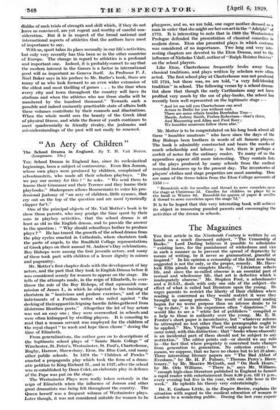An Aery of Children
2,
The School Drama in England. By T. H. Vail Motter. (Longman. 15s.)
Tim School Drama in England has, since its ecclesiastical beginnings, been a subject of controversy. Even Ben Jonson, whose own plays were produced by children, complained of schoolmasters, who made all their scholars playboys. Do we pay our money for this ? " he asks. " We send them to learne their Grammar and their Terence and they learne their playbooks." Shakespeare allows Rosencrantz to voice his pro- fessional jealousy of "an aery of children, little eyasses, that cry out on the top of the question and are most tyranically clapper for't."
• One of the principal objects of Mr. Vail Motter's book is to show those parents, who may grudge the time spent by their
sons in playboy activities, that the school drama is at least as old as the English drama, and to provide the answer to the question : " Why should schoolboys bother to produce plays ? " He has traced the growth of the school drama from the play cycles enacted in Cathedrals, where choristers took the parts of angels, to the Bradfield College representations of Greek plays on their annual St. Andrew's Day celebrations. Boy Bishops were among the first juvenile actors, and many of these took part with children of a lesser dignity in mimes and pageantry.
Mr. Motter's first chapter deals with the development of boy actors, and the part that they took in English Drama before it was considered seemly for women to appear on the stage. He
tells of the attempts made, in the reign of Elizabeth, to over- ' throw the rule of the Boy Bishops, of that squeamish com- mission of James I., in which he objected to the training of
choristers in " lascivious and profane exercises," and of the indictments of a Puritan writer who railed against the decking of theirapparelin feigning bawdie fablesgathered from idolatrous Heathen poets." Altogether the lot of boy actors was not an easy one ; they were overworked in schools and were often kidnapped by strolling players. It is consoling to . read that a woman servant was employed for the children of the royal chapel " to wash and kepe them clean " during the time of Elizabeth.
From generalizations, the author goes on to descriptions of the legitimate school plays of "Sainte Marie College" of
Winchester, St. Peter's, Westminster, St. Paul's, Charterhouse, Rugby, Harrow, Shrewsbury, Eton, the Blue Coat, and many other public, schools. In 1378 the " Children of Fowles " enacted a propaganda play which took the form of a dram- atic petition to King Richard II., and in 1527, after the school was re-established by Dean Colet, an elaborate play in defence of the Pope was put on the stage.
. The Westminster Plays were really taken seriously in the reign of Elizabeth when the influence of Jonson and other great dramatists was being felt throughout the country. The Queen herself was a frequent witness of Westminster plays. Later though, it was not considered suitable for women to be
playgoers, and so, we are told, one eager mother dressed as a man in order that she might see her son act in the " Adelphi" of .1773. It is interesting to note that in 1889 the Westminster Prologue defended the presentation of classical comedies in
modem dress. Eton also presented plays in which costume was considered of no importance. Two long and very inte- resting ehapters are devoted to the Eton Drama, and to the influence of Nicholas Udall, author of "Ralph Roister Doister" on the school players.
Like Eton, Charterhouse frequently broke away from classical traditions, and plays written by scholars were ones acted. The first school play at Charterhouse was not produced till 1724, but there was, we are told, " a very full-blooded tradition" in school. The following verses by a school drama- tist show that though the early Carthusians may not have profited very much by the use of play-books, the school has recently been well represented on the legitimate stage :-
" And let me tell you Charterhouse can send Actors to Berlin for you without end. There are some others besides Beerbohm Tree— Maude, Aubrey Smith, Forbes-Robertson—that's three, And Mannering and Allan and Fred Kerr ; We humbler amateurs follow them afar."
Mr. Motter is to be congratulated on his long book about all these " humbler amateurs " who have since the days of the Boy Bishops been brothers in words of all famous players. The book is admirably constructed and bears the marks of much scholarship and labour ; in fact, there is perhaps a surfeit of notes for the ordinary reader. To many of us the appendices appear still more interesting. They contain lists of the plays produced by many schools from the earliest recorded instances up to the present day. The inventories of players' clothes and stage properties are most amusing. Here are some of the items taken from the Eton College accounts of 1553 :-
" Bromfelds wife for needles and thread to sowe coverlets upon the stage at Christmas 2d. Candles for children to playe by in the haull in Winter 9d. Bromfeld for quyers of paper & needles & thread to sowe coverletes upon the stage 7d."
It is to be hoped that this very interesting book will achieve its object in reassuring puzzled parents and encouraging the activities of the drama in schools.






































 Previous page
Previous page